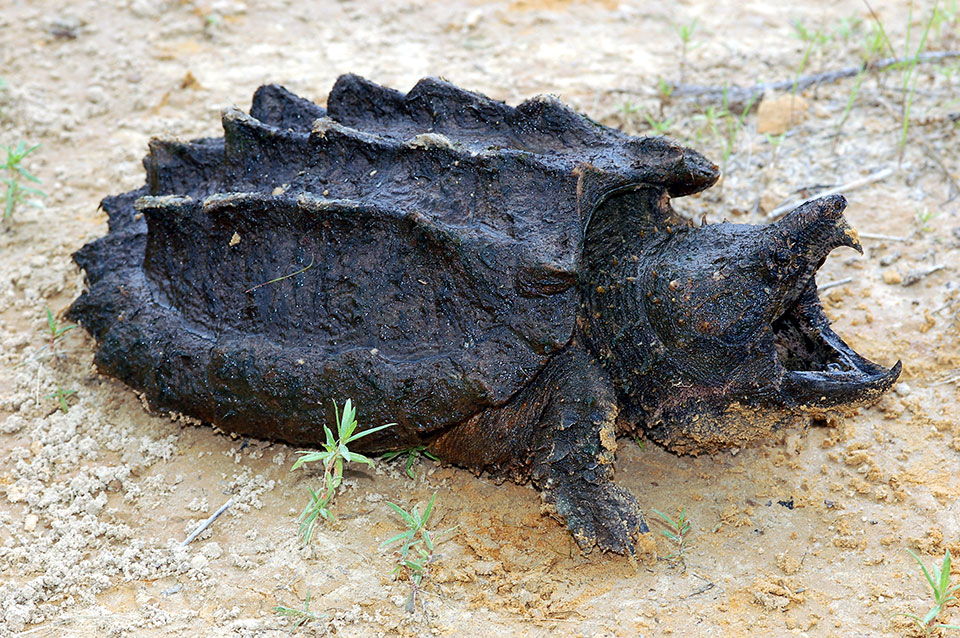
The Kansas Department of Wildlife and Parks announced recently that it will attempt to restore populations of the alligator snapping turtle in southeast Kansas. (Photo courtesy Daren Riedle, Kansas Department of Wildlife and Parks)
Kansas looks to boost alligator snapping turtle numbers
K-State aquatics expert says creature is a benefit to waterways
At a glance: The Kansas Department of Wildlife and Parks announced recently that it will be attempting to restore populations of the alligator snapping turtle in the Neosho River in southeast Kansas. K-State wildlife specialist Joe Gerken explains what that means.
More information: Joe Gerken, 785-532-1418, gerkenje@ksu.edu
Related: K-State Wildlife and Outdoor Enterprise Management
July 19, 2024
By Pat Melgares, K-State Research and Extension news service
MANHATTAN, Kan. – A large, reptilian creature with an intimidating name may be making a comeback in Kansas.
That’s not really a reason for concern among Kansans, says Kansas State University fisheries and aquatics specialist Joe Gerken, noting that the alligator snapping turtle does more good than harm in rural waterways.
The Kansas Department of Wildlife and Parks announced in June that it will be attempting to restore populations in the Neosho River in southeast Kansas. Populations of the alligator snapping turtle – as well as smaller turtles -- have been in decline for more than three decades; in fact, Gerken said the last alligator snapping turtle observed in Kansas was in the early 1990s
“These are big turtles,” Gerken said. “Many people have probably seen common snapping turtles. Well, alligator snapping turtles are like their big cousins. They grow to about twice the size and live for 70 or 80 years. They have these distinct ridges along their back. They look like big, intimidating animals.”
But Gerken notes that alligator snapping turtles are not really a threat to humans – “99% of the time, if you start moving toward them, they are going to be scared of you and run away,” he said.
Gerken added that although alligator snapping turtles are being reintroduced to Kansas, they prefer large rivers and lakes and are unlikely to be found in smaller ponds. Smaller turtles that are found in small ponds -- such as red-eared sliders and common map turtles -- are mostly beneficial to these systems, he said.
Smaller turtles will eat fish in ponds, “but most of these turtles don’t have the ability to eat a lot of fish,” Gerken said. “Mostly what they’re eating is dead matter, decaying detritus (trash or debris). A larger percentage of their diet is vegetarian based. They feed on dead animals in the pond. And so they keep the pond clean, which improves the water quality and keeps the environment healthy for the fish in that pond.”
“The main concern I hear from people is that they worry that these turtles will eat the healthy fish and cause their population to decline,” Gerken said. “But that’s not what’s happening. Mostly what they’re eating is dead matter. They’re eating sick fish, or dying fish, and getting rid of pathogens that could be spread if we allow those animals to stay in the water.”
Some problems have occurred in ponds where landowners feed fish, or in smaller backyard ponds where landowners keep goldfish or smaller fish. In such cases, Gerken said landowners might consider floating turtle traps, but “if it’s in Kansas, you need to have a fishing license to do that.”
“You also need to have a plan with what you are going to do with turtles once they’re trapped. You cannot just take them and dump them somewhere else. If you have large numbers of turtles, it’s best to reach out to your local game warden or conservation agent and explain to them what you’re going to do, and that you understand what you’re allowed to do.”
Landowners can also contact a certified pest control company to remove turtles.
More information on managing wildlife is available online from K-State’s Department of Horticulture and Natural Resources.
***

K‑State Research and Extension is a short name for the Kansas State University Agricultural Experiment Station and Cooperative Extension Service, a program designed to generate and distribute useful knowledge for the well‑being of Kansans. Supported by county, state, federal and private funds, the program has county extension offices, experiment fields, area extension offices and regional research centers statewide. Its headquarters is on the K‑State campus in Manhattan. For more information, visit www.ksre.ksu.edu. K-State Research and Extension is an equal opportunity provider and employer.